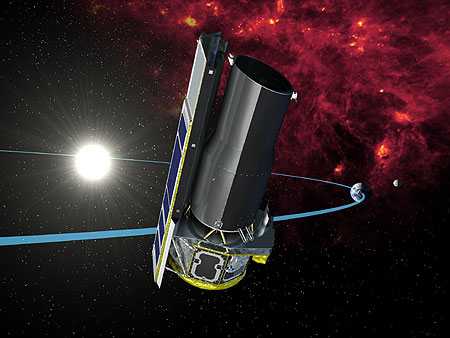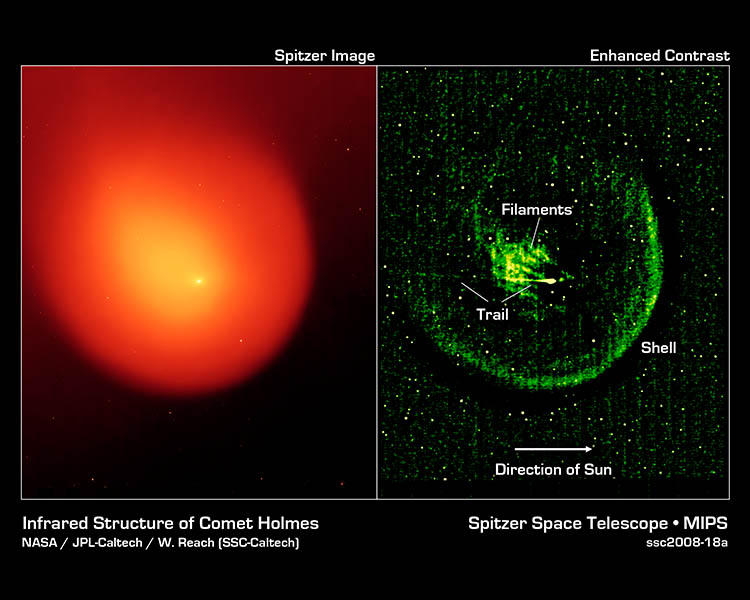The astronomy world buzzed in the Fall of 2007 when Comet Holmes – a normally humdrum, run-of-the-mill comet — unexpectedly flared and erupted. Its coma of gas and dust expanded away from the comet, extending to a volume larger than the Sun. Professional and amateur astronomers around the world turned their telescopes toward the spectacular event. Everyone wanted to know why the comet had suddenly exploded. The Hubble Space Telescope observed the comet, but provided few clues. And now, observations taken of the comet after the explosion by NASA’s Spitzer Space Telescope deepen the mystery, showing oddly behaving streamers in the shell of dust surrounding the nucleus of the comet. The data also offer a rare look at the material liberated from within the nucleus. “The data we got from Spitzer do not look like anything we typically see when looking at comets,” said Bill Reach of NASA’s Spitzer Science Center at Caltech.
Every six years, comet 17P/Holmes speeds away from Jupiter and heads inward toward the sun, traveling the same route typically without incident. However, twice in the last 116 years, in November 1892 and October 2007, comet Holmes exploded as it approached the asteroid belt, and brightened a millionfold overnight.
In an attempt to understand these odd occurrences, astronomers pointed NASA’s Spitzer Space Telescope at the comet in November 2007 and March 2008. By using Spitzer’s infrared spectrograph instrument, Reach and his colleagues were able to gain valuable insights into the composition of Holmes’ solid interior. Like a prism spreading visible-light into a rainbow, the spectrograph breaks up infrared light from the comet into its component parts, revealing the fingerprints of various chemicals.

In November of 2007, Reach noticed a lot of fine silicate dust, or crystallized grains smaller than sand, like crushed gems. He noted that this particular observation revealed materials similar to those seen around other comets where grains have been treated violently, including NASA’s Deep Impact mission, which smashed a projectile into comet Tempel 1; NASA’s Stardust mission, which swept particles from comet Wild 2 into a collector at 13,000 miles per hour (21,000 kilometers per hour), and the outburst of comet Hale-Bopp in 1995.
“Comet dust is very sensitive, meaning that the grains are very easily destroyed, said Reach. “We think the fine silicates are produced in these violent events by the destruction of larger particles originating inside the comet nucleus.”
When Spitzer observed the same portion of the comet again in March 2008, the fine-grained silicate dust was gone and only larger particles were present. “The March observation tells us that there is a very small window for studying composition of comet dust after a violent event like comet Holmes’ outburst,” said Reach.
Comet Holmes not only has unusual dusty components, it also does not look like a typical comet. According to Jeremie Vaubaillon, a colleague of Reach’s at Caltech, pictures snapped from the ground shortly after the outburst revealed streamers in the shell of dust surrounding the comet. Scientists suspect they were produced after the explosion by fragments escaping the comet’s nucleus.
In November 2007, the streamers pointed away from the sun, which seemed natural because scientists believed that radiation from the sun was pushing these fragments straight back. However, when Spitzer imaged the same streamers in March 2008, they were surprised to find them still pointing in the same direction as five months before, even though the comet had moved and sunlight was arriving from a different location. “We have never seen anything like this in a comet before. The extended shape still needs to be fully understood,” said Vaubaillon.
He notes that the shell surrounding the comet also acts peculiarly. The shape of the shell did not change as expected from November 2007 to March 2008. Vaubaillon said this is because the dust grains seen in March 2008 are relatively large, approximately one millimeter in size, and thus harder to move.
“If the shell was comprised of smaller dust grains, it would have changed as the orientation of the sun changes with time,” said Vaubaillon. “This Spitzer image is very unique. No other telescope has seen comet Holmes in this much detail, five months after the explosion.”
“Like people, all comets are a little different. We’ve been studying comets for hundreds of years — 116 years in the case of comet Holmes — but still do not really understand them,” said Reach. “However, with the Spitzer observations and data from other telescopes, we are getting closer.”
Source: Spitzer Press Release


Clearly the effects must be electromagnetic, I’m betting.
no wait
Hi Nancy,
Many thanks for this update review of Comet Holmes.
It was a great event for all those who study our solar system. Although visible to the naked eye it was not well covered in the Media. The reason? no one could answer the basic questions at the time.
I actually have images of the 1892 eruption and no I did not take them myself!
Has Comet Holmes had a second outburst yet? It did several months after being discovered in 1892 when it outburst just like it did last year.
I was wondering if Holmes might have cyclical outburts like Old Faithful or these are just random events, such as an impact or collapse of its ice crust?
I think Holmes is well deserving of a space probe mission to it to see just what is going on out there. Hint, hint, NASA
Aye Karumba! Trust a Lightning Bolts fan to claim it’s “electromagnetic” – sheesh!
My money’s on a collision.
Why pooh-pooh the electric folks? There is little the icy model has to offer on the behavior of Holmes. Who can believe in a 100 year heat capacitor, which is the best explanation the conventional community can come up with (as for collisions, how does that explain a persistent spherical coma much bigger than the sun)? The electric people made predictions that have been realized (for instance, the rocky composition – read, refractory material inclusion); the regular community has scrambled for sensible press releases.
The comet is immersed in an electrified medium, the interplanetary medium (Solar “Wind”), which is a fully-ionized plasma. ANY object that comes into contact with a plasma, will charge because of the faster moving electrons.
Field-aligned Birkeland currents are inferred from the filamentary structure (Mendis, 1978, Moon and the Planets, vol. 18, May 1978), the X-rays detected from Comet Hyakutake (Lisse, 1996, Science, Volume 274, Issue 5285), and a cometary “aurora” (Houpis, 1981 Astrophysical Journal, Part 1, vol. 243).
Electric currents up to a billion Amps have been established in cometary system by Mendis (1978, ibid), Ip and Mendis (1976, Icarus, vol. 29, Sept. 1976).
To ignore electromagnetic interactions is to ignore the basic properties of astrophysical plasmas.
I cant believe i finally found the after action report on this subject. Thank you i was very informative and unclear at the same time.
what about the relative volume\size of the comet in 2007 before the event and in 2008, in correlation to the amount of material being ejected out of it? How is it possible that the comet is still there? Shouldn’t it just be vaporized into dust after such violent expansion?
have anyone heard about resent Nasa THEMIS project? http://www.nasa.gov/mission_pages/themis/main/index.html
so we have 3 events (themis, holmes and deep impact) that suport this whole electromagnetic plasma theory thing. :\